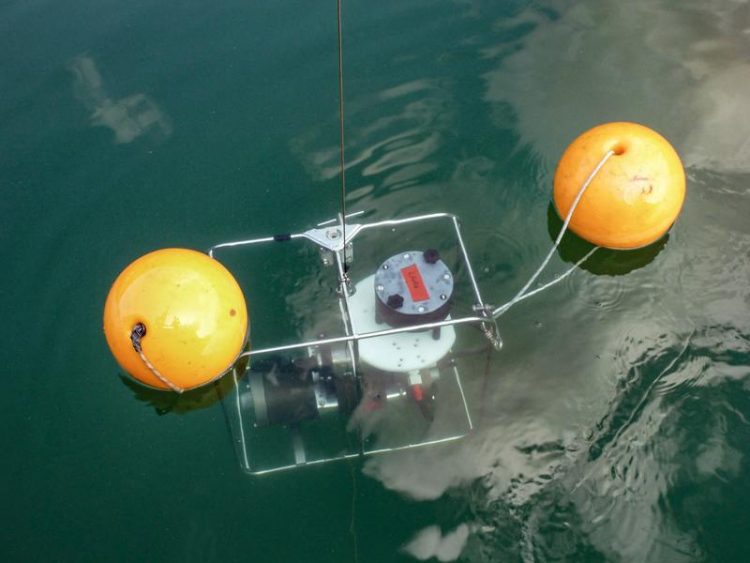Improving paleotemperature reconstruction: Swiss lakes as a model system

The researchers filtered hundreds of liters of water from Lake Lugano at depths of up to 275 m using a battery-operated in-situ pump University of Basel, Department of Environmental Sciences
The remains of bacteria found in lake sediments are important for the reconstruction of past environmental conditions. Particularly, cell fragments known as membrane lipids allow climate geologists to infer historic temperatures. A team led by Professor Moritz Lehmann and Dr. Helge Niemann from the Department of Environmental Sciences at the University of Basel have now investigated a very specific class of climate-sensitive lipids in 36 alpine lakes.
Their application in climate reconstruction has long been known, but the biological sources of the lipids remained unclear. This severely complicated their application as a temperature indicator.
“We initially assumed that these compounds were primarily produced by bacteria in soil and were washed into the lakes by rivers. But increasing evidence suggested that they are also formed within lake water itself,” explains Lehmann. Therefore, the aim of the research project was to characterize the ecology of the unknown bacteria that produce these lipids.
Link to methane
At the heart of the investigations was Lake Lugano in Switzerland, which offers an outstanding model system due to its strong stratification and great depth.
“Using stable isotope analysis, we were able to show that these bacterial lipids are dominantly formed in the cold, deep waters of the lake – where oxygen is depleted and large amounts of the greenhouse gas methane are present,” says Dr. Yuki Weber, lead author of the study. The scientists were then able to confirm their findings from Lake Lugano by similar measurements from 35 other alpine lakes.
In addition to lipid analysis, the researchers also applied molecular biological methods, which allowed them to capture the bacterial diversity at various water depths in Lake Lugano. For the first time, the research team was able to show that these climate-sensitive lipids are produced under widely different environmental conditions, by distinct groups of microbes that reside at different water depths.
Refining the paleothermometer
Despite the numerous environmental factors that may influence the composition of these lipids, the researchers were able to determine the conditions under which the lipid thermometer still yields reliable temperature estimates. “By means of stable carbon isotope analysis, we can now determine whether the lipids were formed in soil or lake water. We are therefore confident that our study will make an important contribution to the improvement of paleoclimate data worldwide,” concludes Weber.
The study was carried out in cooperation with the Royal Netherlands Institute for Sea Research, ETH Zurich, University of Applied Sciences and Arts of Southern Switzerland, and Eawag.
Professor Moritz Lehmann, University of Basel, Department of Environmental Sciences, Tel. +41 61 207 36 16, email: moritz.lehmann@unibas.ch
Yuki Weber, Jaap S. Sinninghe Damsté, Jakob Zopfi, Cindy De Jonge, Adrian Gili, Carsten J. Schubert, Fabio Lepori, Moritz F. Lehmann, Helge Niemann
Redox-dependent niche differentiation provides evidence for multiple bacterial sources of glycerol tetraether lipids in lakes
PNAS (2018), doi: 10.1073/pnas.1805186115
Media Contact
More Information:
http://www.unibas.chAll latest news from the category: Life Sciences and Chemistry
Articles and reports from the Life Sciences and chemistry area deal with applied and basic research into modern biology, chemistry and human medicine.
Valuable information can be found on a range of life sciences fields including bacteriology, biochemistry, bionics, bioinformatics, biophysics, biotechnology, genetics, geobotany, human biology, marine biology, microbiology, molecular biology, cellular biology, zoology, bioinorganic chemistry, microchemistry and environmental chemistry.
Newest articles

Sea slugs inspire highly stretchable biomedical sensor
USC Viterbi School of Engineering researcher Hangbo Zhao presents findings on highly stretchable and customizable microneedles for application in fields including neuroscience, tissue engineering, and wearable bioelectronics. The revolution in…

Twisting and binding matter waves with photons in a cavity
Precisely measuring the energy states of individual atoms has been a historical challenge for physicists due to atomic recoil. When an atom interacts with a photon, the atom “recoils” in…

Nanotubes, nanoparticles, and antibodies detect tiny amounts of fentanyl
New sensor is six orders of magnitude more sensitive than the next best thing. A research team at Pitt led by Alexander Star, a chemistry professor in the Kenneth P. Dietrich…





















